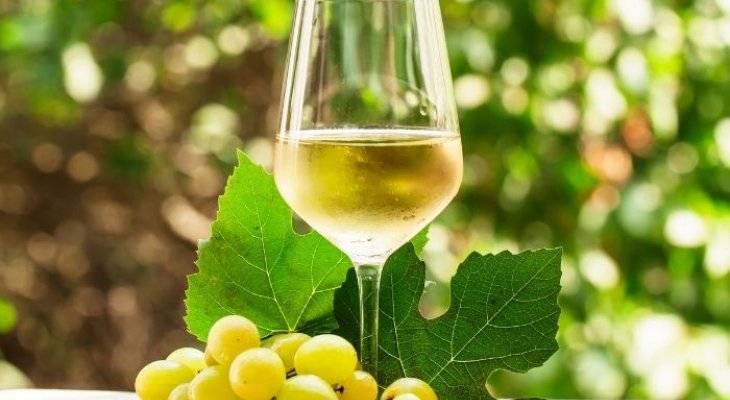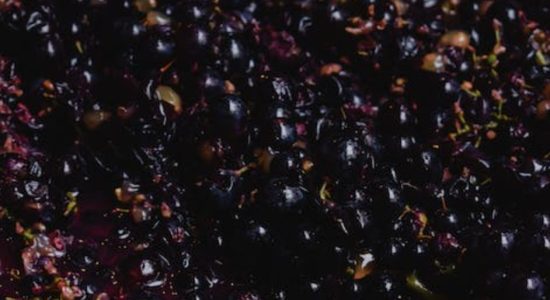What is a Dry White Wine? (Complete Guide)

Most people associate dry white wines with cooking. However, their uses are not limited to the kitchen only.
Dry white wines come in many varieties with many different uses. Whether you want to step up your cooking game, you want to broaden your wine pallet, or simply need a refresher on the subject, there’s a lot to know about dry white wines.
But, What is a Dry White Wine? Dry wines come from the fact that there is no residual sugar left in the wine. The fermentation process has been extended so that there is no sugar left behind, leading to wine high in acidity (called crisp) and often with citrus tones. These wines can be red or white, not just white, but dry white wines tend to be more popular.
Here’s everything you’d want to know about the types and uses of dry white wine.
Dry White Wines 101
It’s important to note how these wines get their dryness before talking about what makes them good.
If you already know this stuff, go on down to the types of dry white wines. If you don’t know or need a refresher, here are how you talk about the flavors in a wine.
Wines have several different ways they get their flavors. Of course one of the elements is the type of grapes used. That obviously gives wine a lot of its character.
Here, we’re talking about wines made from white grapes, hence, white wine.
The grapes too will usually determine how much alcohol is in the wine, called its body.
Light-bodied wines are less than 12.5% ABV. Medium-bodied are between 12.5 and 13.5% ABV, and full-bodied are above 13.5% ABV.
The reason why this is is because the amount of viscosity, or thickness, of the wine is determined by the amount of alcohol in the wine. Hence, a full-bodied wine will have both more alcohol and feel thicker, heavier, in your mouth!
Wines and Flavors: Explanation
Wines have some elements that contribute to how any wine tastes. Some of these are:
- Terrier (the flavors that come from where the grape is grown)
- Tannis (its sourness or perhaps “pucker power”)
- Harvest date (the later the sweeter!)
- Aged flavor (coming from the barrels it is aged in).
Now, put that all together, and you’ve got a wine made from white grapes, that fermented for a longer period of time so that not residual sugar was left. Hence, a wine that isn’t sweet, and is white!
What is a Good Dry White Wine?
A good dry white wine will often be crisp and have fruit or earth tones, not too sweet, and it will sit on your palette – it’s not going to go away fast.
Food pairing with these wines is key, as often people dislike drinking them on their own. But if you like it that way, go right ahead.
While price might be a definite way to tell you’ve got something good, there are plenty of other ways to get wines that are ahead of the rest.
Oftentimes, being aged for longer will provide certain flavors. The type of grape too will contribute to whether a wine is full-body or something different.
A couple things to note:
- A common misconception is that “fruity = sweet.”
However, dry white wines often do have fruit tones, but those tones don’t necessarily mean the wine is sweet. On the contrary. These dry white wines might have mango, apple, pineapple, and many other fruity tones, but not be sweet at all.
REMEMBER: Just because they’re fruity doesn’t mean they are sugary.
Learn about sugar in the winemaking process.
- Dry white wines are very good for drinking.
Once you use them to cook, keep them around and enjoy a glass with your dinner, or vice versa. They might not be what you’re used to drinking compared to that sweet bottle of red wine you have lying around, but do yourself a favor and expand your flavor palette with dry white wines.
List of Dry White Wine Types
Here is a really good list of dry white wines and their various uses. I’ll sum up the different types of white wine they have listed for you right here.
Wines from these grapes usually end up dry – with a few exceptions -.
These wines are all over the price range as well as all over the range of flavors and notes. Just because a wine is defined as “dry” doesn’t mean that there isn’t a whole range of flavors there waiting to be discovered.
Chardonnay
One of the most popular white wines, Chardonnay’s have a lot of earthy tones, but they can be adapted depending on how they’re aged and the style of the winemaker.
Sauvignon Blanc
Wine full of citrus flavors and with a high acidity, often accompanied by grassy tones.
Pinot Grigio / Pinot Gris
Two different names for the same grape with the same acidic taste.
Riesling
While a lot of people think Rieslings are used in sweet white wines, they’re also very common in dry white wines too!
Pinot Blanc
Often seen as a close cousin or maybe a younger sibling of Chardonnay wines, they have a lot of the same tones and also the same malleability.
Viognier
Comparable to Chardonnay but with more flower tones than earthy.
Grüner Veltliner
Austrian native wine, known for its spicy and crisp tones.
Semillon
Known more for blending to add fruity flavors to other white wines.
Albarino
Slightly bitter taste accompanies citrus taste in this Spanish variety of dry white wine
Melon de Bourgogne (Muscadet)
The grape gets its fame from being the primary or only grape in the white wine Muscadet.
Is Chardonnay a Dry White Wine?
On its own, Chardonnay would usually be a dry white wine. However, with different barrels, and age, a Chardonnay could be a sweet white wine or a dry one. For example, a chardonnay aged in oak, also known more simply as oaked chardonnay, will often bring out vanilla flavors that make the wine much sweeter and much less dry.
As you can see, Chardonnay’s are a bit tricky.
What makes it so popular? The main ingredient in its popularity is its versatility. Part of that versatility is that the grape is simply easy to grow. The other is that Chardonnay’s flavors are very, very versatile.
Is Sauvignon Blanc a Dry White Wine?
Sauvignon Blanc is also typically a dry white wine, when it’s not blended with other wines to create dessert wines. Sauvignon Blanc shows just about as much terrier as Chardonnay, but noticeably less flavor from how it is aged. It is also a famous white wine grape.
Sauvignon Blanc is typically higher in alcohol content than Chardonnay.
Find out more about Sauvignon Blanc wines here.
What is the Driest White Wine?
It’s commonly accepted that the driest white wine is Muscadet. Made with the Melon de Bourgogne grape exclusively grown in Burgundy, France, this wine has mineral and earth tones. It has citrus notes as well. This wine will definitely make you pucker up.
However, Sauvignon Blanc is not far behind in the dryness scale, and many Chardonnay’s aren’t far behind. Here is a list of the driest white wines.
Dry White Wine for Cooking: The Basics
Here’s the thing about dry white wine; if you wouldn’t drink it, you probably won’t like it in your food.
Buying crappy dry white wine that tastes like vinegar won’t add anything to that creamy sauce. It’ll just taste burnt or nasty or bitter to you. Heat won’t take away the bad qualities of bad wine.
As mentioned above, cook with what you drink. Buy a Chardonnay and use it for your stew, and enjoy a glass with dinner.
Don’t use that Chardonnay that you hate and then expect it to liven up your stew.
Of course that doesn’t necessarily mean that you have to like the flavors of the particular wine you’re using; however, if the wine is crappy in the wineglass, it’ll be crappy for the dish.
TIP: Avoid wines labeled as “cooking wines.” If they weren’t good enough to drink, chances are they won’t be good enough to cook with.
On the flip side, the cooking process will also kill the complexities of great wines. So no, don’t scrape the bottom of the barrel, so to say. But also, don’t use your best wine – there comes a point where you have to draw the line.
A good wine will make your cooking good, but a great wine won’t necessarily make it great. Save the best stuff for the glass!
Remember that if you uncork a wine, it’s best to drink it soon even if you recork it or else it will oxidize and not taste as good. At that point, it’s totally fine and will usually save you all your flavors if you use it for cooking.
What Are the Best Dry Wines for Cooking?
The top-notch dry white wine for cooking is usually Pinot Grigio. Even though dry, it has less citrus or earth or really any tone compared to the next two. Sauvignon Blanc -on its own- is also a go-to for cooking. Unoaked chardonnay, in contrast to the sweeter flavors of oaked chardonnay, is great as well and often cheaper for a still good quality.
Oaky wines, wines with a lot of sweetness, and buttery wines are not good for cooking because the sugar in them often burns and turns bitter when cooking.
While Chardonnay is so versatile, in its dry white form it has much less versatility than Pinot Grigio.
Of course, the above mentioned aren’t the only dry white wines you can use for cooking:
- Dry white sherry is also extremely useful for cooking, and it keeps longer than other wines.
- Dry white marsala is in the same boat. If you want to try out wine in your dishes every once and awhile, these are good bets.
- Dry Madeira can serve as a substitute for sherry in almost all recipes that have sherry in it, as well as bringing its own flavor profile to the table in certain dishes.
- Leftover bubbly can be also used in a meal because the bubbles will dissipate during the cooking process.
- Dry Vermouth can be a great white wine alternative. It can be used in all sorts of dishes and also lasts longer when opened then white wine does.
Dry White Wines for 6 Different Recipes
Sometimes you’ll be reading a recipe, and all of a sudden it’ll say, “Now, add a cup of dry white wine.” Whoa whoa whoa! you might think. We’ve skipped a step here!
Sometimes a recipe will assume you’ll know what goes with what. Even if they do list something, maybe that wine is out of your price range. Or you just don’t know why they put in what they put in. All of these are great questions to ask about dry white wine.
You may be wondering, why add dry white wine to my recipe in the first place?
Generally, the alcohol of the wine is going to burn off in the cooking, so that’s not why you add it.
When you add a wine, you’re looking for its flavor. What it brings to the table is what it brings to your dish -that’s why you don’t want to use cheap stuff.
Generally, the options I listed above are versatile for most cooking recipes. If you’re looking for something specific, though, here I have a list of some common wines used in these recipes. Take note!
While you can find plenty of individual recipes online, here are some general guidelines you’ll be looking for while cooking with dry, white wines in these areas:
1. Risotto
You brought up the risotto recipe, and it calls for a glass of wine. Now, you’re sitting here and dinner is in a few hours, and you don’t know what wine to throw in. What should you do?
Have no fear, because risotto works the best with any of the options I listed.
Sauvignon Blanc is recommended in particular, but you can never go wrong with Pinot Grigio, and unoaked Chardonnay will get you similar results to Sauvignon.
Again, take note -avoid those cheap wines. Get something that counts but don’t use your best!
2. Chicken
Chicken is wonderful. It is so cheap and can be cooked in so many different ways. And when the time comes and you’re trying out cooking with wine, there’s no place better to go than chicken.
If you’re thinking of making chicken with some sort of creamy sauce, then Chardonnay is the best option for you, especially unoaked. Chardonnay provides this thick, creamy texture that while somewhat present in the wine itself really comes out with all kinds of meats.
Gravy or white cream sauce require a steady hand to balance the acidity with the amount the wine will reduce in the cooking process, but it’s definitely feasible.
Other wines that I described before, including Viognier, work very well too. However, Chardonnay is the most widely available, again it doesn’t hurt to lean back on old faithfuls for cooking rather than the cream of the crop.
3. Seafood
A little bit of acidity coupled with fruity or mineral tones fits so well with seafood and fish. A dash of acidity will cut through the fat of a big fish, or give dimension to a piece of shrimp. Of course, you could do this by putting some lime wedges on top of your fish, but where’s the fun in that?
Pinot Grigio is valuable for its blank slate, and Sauvignon can provide that earthy, grassy tone that might fit just right with your cooking. Stick with the Pinot Grigio and branch out if you feel like experimenting. See what the recipe calls for!
4. Bolognese
A thick, meaty Bolognese sauce is ready to be simmered on the stove. You might think that a rich red sauce would need a rich red wine. Contrary to popular belief, some of the most highly rated recipes online don’t call for red wines, but instead a dry white wine to balance out the other ingredients, like milk.
What to do? Which wine to choose?
Get out that Sauvignon again because its high acidity will do wonders for a Bolognese sauce that is slowly simmered. Don’t be afraid to scour around internet boards (like you’re doing right now I suppose!) to see what wines specifically have worked for others in the past. Use that sauvignon blanc to make a bolognese sauce that truly feels special!
5. Deglazing
One of the best reasons to use dry white wine is actually after the cooking to make the sauce that goes with your meal. This is called “deglazing.”
Deglazing is the act of dissolving the brown bits after your meal is done in the pan.
When you take that seafood or that poultry or that meat off the pan, when they’re done sautéing or searing or roasting, there’s going to be some residue left behind. Turn those meaty bits into a savory sauce with your meal by pouring that dry white wine onto the pan and scraping the bottom with a wooden spoon.
Pinot grigio is the most basic because it’ll more readily absorb those flavors and make them rich, but the other two work just as well depending on what you’re making.
6. Sangria
This technically isn’t cooking, but in the summer months, a crisp, citrusy white sangria is just the refresher any adult would need.
While you might think that red sangrias are all there are, the acidic taste of a white sangria is unmatched. Branch out and try something new with some totally new flavors in a familiar form.
Dry, unoaked, and crisp is again the name of the game. Return to Pinot Grigio or Sauvignon Blanc for that crisp flavor as well as the citrus to make your sangria really pop.
Here is a recipe that I found that I think makes some of the best white sangrias: Easy White Sangria!
Final Thoughts
Dry white wines are key to enjoying the full range of tones, notes, flavors, and cooking options that wine has to offer. Don’t leave this huge part of wine out of your picture.
Broaden your horizons by tasting some or cooking with dry white wine. Dry white wine is the way to go!







